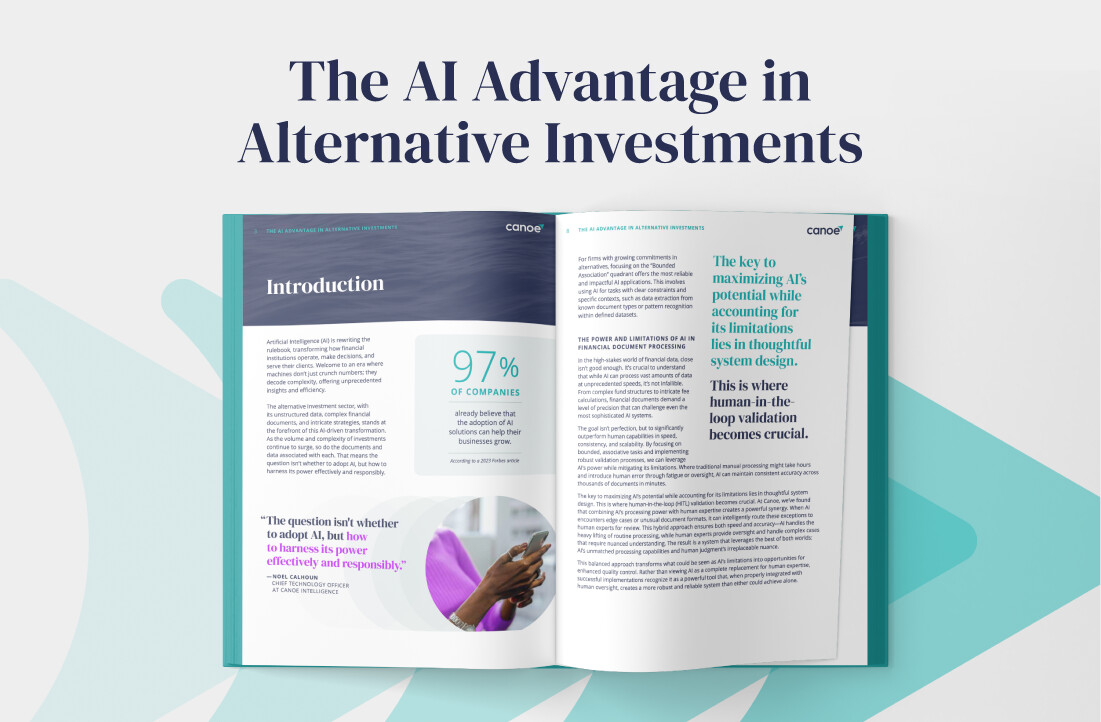Too many rules, too many reports: Conquering Europe’s alternatives problem
Alternative investing is surging across Europe, booming in areas such as Spain, where transaction volumes grew 37% year-over-year. For family offices and institutional investors, managing these growing portfolios requires more than a keen ability to identify opportunities. It requires significant time and cost in managing regulatory reporting and compliance.
Oversight from multiple authorities, including ESMA, and overlapping regimes such as AIFMD, MiFID II and SFDR, create a maze of obligations. To comply, investors must piece together a fractured landscape of documents and disclosures, where each jurisdiction reports according to its own format, timeline, and definitions. The inconsistencies can easily drive up error rates, leaving family offices and institutional investors exposed to regulatory scrutiny and penalties.
Across this landscape, AI data intelligence platforms are changing how investors manage compliance, bringing efficiency to regulatory reporting that can drive down costs.
Alternatives move from niche strategy to portfolio standard.
Across much of Europe, the balance of capital is shifting. Institutional investors and family offices—once firmly rooted in public markets—are channeling ever greater sums into alternatives.
While alternatives were once considered the periphery of investment strategy, today 49% of European family offices portfolios are invested in alternative asset classes, with the exception of Switzerland, where alts make up a slightly smaller 44% of portfolios.¹
Private market allocations from institutional investors are following a similar trend. While private alternatives, including foundations and endowments, currently make up around 20% and 30% respectively of institutional investor portfolios, 75% of respondents to a recent survey plan to increase market exposure over the next 2 years.²
One compelling reason behind the shift is the shrinking number of publicly available companies—down from 7,300 in 1996 to 4,300 today.³ In this environment, private market asset classes offer an opportunity that is hard to ignore, particularly when considering where the money is flowing. Of the 159,000 companies earning annual sales of $100 million or more globally, a significant 140,000 are under private ownership.⁴
Private equity offers the potential for larger gains in both developed and emerging sectors, while infrastructure and real estate provide more stable, income-linked streams of inflation. Offering similar advantages, private credit opens the door to attractive income yields with downside protections. These attributes are particularly attractive to investors with long horizons and defined obligations, like pension funds and insurers, or those focused on preserving family legacies for generations to come.
Reporting complexity rises as alternative allocations grow.
Despite the numerous opportunities for returns and portfolio diversification, institutional investors and family offices face a multitude of challenges as they strive to reach the summit of peak performance. Unlike public market opportunities, alternatives are opaque. Valuations aren’t real-time. Returns aren’t linear. And reporting is anything but standardised.
Additionally, allocation patterns exhibited by European institutional investors and family offices are highly influenced by the regulatory, legal, and reporting environments of the governments under which they operate. These frameworks can be distinctly different from one country to the next, resulting in substantial reporting challenges when investing across borders.
For instance, in Sweden and Denmark, where investors have a strong preference for sustainability, institutional investors and family offices face intricately detailed sustainability reporting mandates, such as the Sustainable Finance Disclosure Regulation (SFDR) and the EU Taxonomy. Clients expect deep transparency regarding environmental impacts, including carbon emissions, diversity, and supply chain risks. These expectations necessitate a more comprehensive level of reporting, often resulting in data requirements that exceed what regulations mandate in jurisdictions where investments originate.
Elsewhere in Europe, reporting takes different, but equally burdensome forms. In Germany, strict quota rules require institutions to demonstrate compliance through detailed disclosures. While Swiss investors may experience more freedom when it comes to using customised legal structures, the flexibility comes at the added cost of reconciling data across multiple jurisdictions and formats.
The tremendous patchwork of regulations, legal structures, and frameworks across European markets creates a broken network of reporting requirements. Considering the differences in languages, templates, and disclosure standards, as well as varying reporting frequencies and levels of granularity, entities are left to gather and harmonise a wide spectrum of inputs.
Add in the fact that LPs don’t invest with a single entity or within a single region. Most portfolios include allocations across countries and legal structures, increasing data fragmentation and jurisdictional complexity. The result is a resource-intensive effort to collect usable data and deliver compliant reports.
Reporting can require access to multiple documents, including fund reports, investor letters, ESG disclosures, valuation updates, tax documents, capital calls, and distributions, to name a few. The complexity grows when you realise that there is no consistent data format. Capital calls arrive as PDFs, valuations live in spreadsheets, ESG data appears in various custom structures, and disclosures vary by country and regulator. Gathering data, extracting insights, creating reports, and other such administrative and compliance duties create a significant burden, eating away up to 18% of each day.⁵
How AI rewrites the reporting equation.
The advent of artificial intelligence is changing this equation for institutional investors and family offices. AI-driven intelligence automatically ingests documents from multiple sources in any language and extracts pertinent details. To ensure validity, entities have the flexibility to execute hundreds of data rules.
However, AI-driven data management can do more than collect information from disparate sources. It normalises data, extracting key points and mapping inputs to reporting frameworks. By automating data collection and categorisation of investment documents, investors reduce the burden on staff and generate reports in significantly less time. AI can reduce the time spent collecting documents alone by 94%.⁶
Since allocations are often spread across various jurisdictions, LPs run the risk of misreporting and incurring additional regulatory scrutiny. AI platforms ensure consistency by mapping the same data source across varying regulatory templates. Since logs are kept on the source data location, strong audit trails further enhance the reporting cycle.
In a market defined by fragmented data and complex reporting obligations, AI-powered data intelligence reduces reporting risk by ensuring disclosures are generated faster and more accurately across jurisdictions.
¹ UBS Global Family Office Report 2025: all Eyes on the Global Trade War.” UBS, May 21, 2025. Web.
² “Pursuing Private Assets for Diversified Returns.” Institutional Investor, Feb. 5, 2025. Web.
³ Alex Davies. “Profiting from the Potential of Private Markets Has Become More Affordable.” MoneyWeek, Jul. 27, 2025. Web.
⁴ Alex Davies. “Profiting from the Potential of Private Markets Has Become More Affordable.” MoneyWeek, Jul. 27, 2025. Web.
⁵ “Defining the Family Office Landscape.” Deloitte. Retrieved from https://www.deloitte.com/nl/en/services/deloitte-private/about/defining-the-family-office-landscape.html. Aug. 26, 2025.
⁶ “Automated Alternatives Document & Data Management.” Canoe Intelligence. Retrieved from https://canoeintelligence.com/wp-content/uploads/2024/07/Canoe-Intelligence-Company-Overview.pdf. Aug. 26, 2025.




